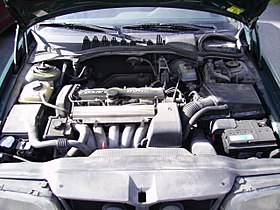T5 engine
| Volvo Modular Engine | |
|---|---|
 |
|
| Overview | |
| Manufacturer | Volvo Cars |
| Production | 1990–2016 |
| Combustion chamber | |
| Configuration | I4, I5, I6 |
| Displacement | 1.6L–2.9L |
| Cylinder block alloy | Aluminum |
| Cylinder head alloy | Aluminum |
| Valvetrain | DOHC |
| Combustion | |
| Fuel system | Fuel injection |
| Management |
Bosch LH-Jetronic Bosch Motronic Bosch ME Motronic Siemens Fenix Siemens EMS 2000 Denso EMS Necam MEGA |
| Fuel type |
Petrol LPG CNG |
| Oil system | Wet sump |
| Cooling system | Water-cooled |
| Chronology | |
| Predecessor |
PRV (6cyl) Redblock (4cyl) |
| Successor |
VEA (general replacement) SI6 (6cyl) |
| Exhaust | |
| Emissions target standard | Euro 1 - Euro 5+ |
| Emissions control technology | Catalytic converter EGR |
The Volvo Modular Engine was a family of straight-four, straight-five, and straight-six automobile piston engines produced by Volvo Cars in Skövde,Sweden from 1990 until 2016. All engines feature an aluminum engine block and aluminum cylinder head, forged steel connecting rods, aluminum pistons and double overhead camshafts.
The Volvo Modular Engine was developed as part of Project Galaxy which began in the late 1970s. The prototype engines called X-100 had only four cylinders but already featured the sandwich and all aluminum construction of the later production variants. Early prototypes of the X-100 were designed similar to the existing redblock engines with a single camshaft and the oilfilter mounted on the side of the engine rather than the bottom.
The first available engine was the B6304F which debuted in August 1990 in the Volvo 960. A year later, with the introduction of the Volvo 850 in June 1991, the first five-cylinder variant in form of the B5254F hit the market. It was equipped with V-VIS (Volvo Variable Intake System) which was designed to improve engine response between 1500–4100 rpm. V-VIS was only available on the 2,5L 20V naturally aspirated engines and was discontinued after 1994. In 1995 with the launch of the Volvo S40 the four-cylinder B4184S and B4204S engines were released. The same year Volvo shared the B4204S and B5244S engines with Renault, who used them in the Laguna and Safrane models under the name N7Q and N7U.
In 1998, with the introduction of the 1999 model year S80, Volvo began to transition to updated versions of their 'N'-series engines, now called 'RN', short for revised 'N'. Drive-by-wire, coil-on-plug systems and variable valve timing (VVT) were introduced along with new engine management systems. 10 valve engines were slowly phased out in favour of detuned 20 valve versions.
With the introduction of the second generation Volvo S40 in 2003 another update to the engine family took place. The new engine was called 'RNC', the 'C' standing for 'compact' to emphasise the decrease in overall dimensions. Compared to the previous generation the new engine was 200mm slimmer and 25mm shorter. On turbocharged engines the exhaust manifold and turbine housing were now combined into one part; all engines were equipped with plastic intake manifolds and continuously variable valve timing (CVVT).
The 'RN' engines remained in production alongside the 'RNC' engines and were slowly phased out, beginning with the introduction of the second generation Volvo S80 in 2006. The new SI6 engine family was introduced to replace the 6-cylinder variants of the Volvo Modular Engine at the same time.
...
Wikipedia
